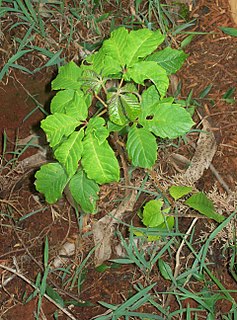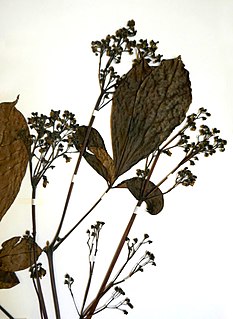
Vitex is a genus of flowering plants in the sage family Lamiaceae. It has about 250 species. Common names include chaste tree or chastetree, traditionally referring to V. agnus-castus but often applied to other species as well.
This article is a list of biological species, subspecies, and evolutionary significant units that are known to have become extinct during the Holocene, the current geologic epoch, ordered by their known or approximate date of disappearance from oldest to most recent.

Carpoxylon macrospermum is a species of palm tree endemic to Vanuatu, and the only species in the genus Carpoxylon.
Horsfieldia urceolata is a species of plant in the family Myristicaceae. It is endemic to Papua New Guinea.
Tylophora urceolata is a species of plant in the family Apocynaceae. It is found in Cameroon, Equatorial Guinea, and Tanzania. Its natural habitat is subtropical or tropical dry forests. It is threatened by habitat loss.
Vitex acunae is a species of plant in the family Lamiaceae. It is endemic to Cuba. It is threatened by habitat loss.
Vitex ajugaeflora is a species of plant in the family Lamiaceae. It is endemic to Vietnam.
Vitex amaniensis is a species of plant in the family Lamiaceae. It is endemic to Tanzania.
Vitex cooperi is a species of plant in the family Lamiaceae. It is found in Costa Rica, Guatemala, Honduras, Nicaragua, and Panama.
Vitex evoluta is a species of plant in the family Lamiaceae. It is endemic to New Caledonia.

Vitex gaumeri is a species of plant in the family Lamiaceae. It is found in Belize, Guatemala, Honduras, and Mexico.
Vitex heptaphylla is a species of plant in the family Lamiaceae. It is found in Cuba, Dominica, the Dominican Republic, and Haiti.

Vitex keniensis is a species of plant in the family Lamiaceae.
Vitex kuylenii is a species of plant in the family Lamiaceae. It is found in Belize, Guatemala, Honduras, Mexico, and Nicaragua.

Vitex lehmbachii is a species of plant in the family Lamiaceae. It is endemic to Cameroon. Its natural habitat is subtropical or tropical moist lowland forests. It is threatened by habitat loss.
Vitex longisepala is a species of plant in the family Lamiaceae. It is a tree endemic to Peninsular Malaysia.

Vitex parviflora is a species of plant in the family Verbenaceae, also known as smallflower chastetree or the molave tree. It is found in Indonesia, Malaysia, and the Philippines. It is threatened by habitat loss. The name "molave" is from Spanish, derived from Tagalog mulawin. It is also known as tugas in Visayan languages.
Vitex yaundensis is a species of plant in the family Lamiaceae. It is endemic to Cameroon. Its natural habitat is subtropical or tropical moist lowland forests. It is threatened by habitat loss.
Vitex zanzibarensis is a species of plant in the family Lamiaceae. It is found in Kenya and Tanzania. It is threatened by habitat loss.

Vitex rotundifolia, the roundleaf chastetree or beach vitex is a species of Vitex that is native to seashores throughout the Pacific. Its range includes continents and islands stretching from India east to Hawaii and from Korea south to Australia. This woody perennial plant typically grows approximately 1 m in height. It has a sprawling growth habit and produces runners that root regularly at nodes. This rooting pattern allows the plant to spread rapidly. At maturity, V. rotundifolia produces blue-purple flowers that are borne in clusters and ultimately yield small brown-black fruits. Its leaves are rounded at the tips with green upper surfaces and silver lower surfaces. While the plant is a seashore obligate, it grows over a wide latitude range. It has been used for medicinal purposes throughout its native range. More recently, it was imported to the eastern United States where it has become a seashore invasive. Control efforts are presently underway to protect the fragile beach dune ecosystem.







